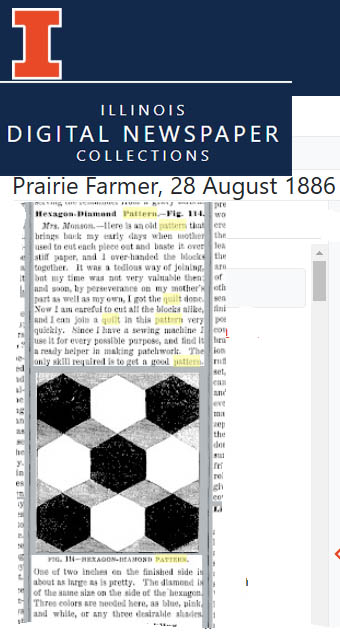Kentucky quilt
Silk in Kentucky seems to have been rather abundant as one characteristic of the state's quilt history is many silk patchwork extravaganzas from about 1840 on. Despite the mountainous area's inaccessibility in the age of railroads the quilts give us much evidence of the luxury fabric's availability, at least in the major cities of Lexington and Louisville.
Kentucky quilt in satins, velvets and brocades from the Filson Society's collection.
Kentucky Historical Society
Silk Star of Bethlehem attributed to Ann Eliza Belrichard
Bryan (1835-1867) of Louisville
A subset of Kentucky's quilt heritage is a group of quilts from rural Logan County, attributed to the plantation called The Knob near Russellville.
The silk quilts are unusual in their shared star designs and stuffed-work
quilting. The three are attributed to the enslaved seamstresses at the Morton family's
plantation the Knob.
The Knob about 1860
Not exactly the nostalgic image of the old Kentucky home but
the buildings to the right are the homes of the slaves,
which included Ellen and Margaret to whom the quilts are attributed
by the Morton owners who donated them.
Russellville would seem an unlikely spot to find such sophisticated silk fabrics before the Civil War and the late-19th-century abundance of silk factory cutaways that were made into crazy quilts. Quilts grow out of the available fabric. How was this luxury fabric, primarily produced in China, available to the Morton women?
A Shaker sister named Indiana Pilkington wearing the
traditional sisters' accessory of a silk scarf. The photos
are from the Shaker Museum at South Union, KY.
I was re-reading Claire Somersille Nolan's 2005 paper "The Star of Bethlehem Variation Quilt" in Uncoverings 26 and realized she had a ready answer. Near Russellville a Shaker community thrived for many years. Claire tells us:
Americans interested in communal living and silk culture tried silk production, but maintaining the silk worms and harvesting their filament was just not suited to the American temperament and experiments soon failed. The Chinese were masters of sericulture and continue to be today. The Shakers' interest in silk production and the sale of their silk scarves probably affected Kentucky quilts style down by the Tennessee border.
Read Claire's paper here:
https://digitalcommons.unl.edu/do/search/?q=author%3A%22Claire%20Somersille%20Nolan%22&start=0&context=52045&facet=
She found out quite a bit about Ellen Morton Littlejohn and Margaret Morton Bibb. The Morton slaveholders were skillful at keeping records of their own lives and often mentioned the Black people who lived with them. Both women were daughters of Eve (born about 1805) who also had three boys Dick, Joe and John (or was it Ned.) The Shaker Museum has Morton family files where Claire found this photograph.
Plantation owner Marmaduke Morton's son David was born in 1833 and his mother died soon after his birth. He recalled being raised by his stepmother (his mother's sister) and "Aunt Eve, who nursed me as a baby and both caressed and scolded me as a little child."
Claire did her research 20 years ago. I bet we can find out quite a bit more about
Eve and her family today and a couple of other quilts attributed to the Mortons.
UPDATE:
A 1993 paper on Shaker silk production, which seems to have begun in the 1830s.
Parker, Donna C. and Jeffrey, Jonathan J. Sericulture, Silk and South Union Shakers.
The Shaker Messenger, Volume XV, Number 1, 1993.
"Extant Shaker kerchiefs in the collections of Shakertown at South Union and The Kentucky Museum at Western Kentucky University reveal the color combinations the Shakers produced. Rose, lavender, purple, and white examples make up the bulk of these collections, but items of a green, a mustard, and a brown plaid also exist. In 1869, Sarah Bates of Mount Lebanon, New York, wrote to Eldress Nancy that she was "fitted out for nice silk Handkerchiefs, of many qualities and many colors. One White, three mixed colors Red blue &c and mostly by your hard labors, at Pleasant Hill and South Union." Many times Shaker Sisters wove handkerchiefs so they had a "changeable," or iridescent quality. They achieved the illusion by using one color for the warp thread and another color for the filling."
https://digitalcommons.wku.edu/dlsc_fac_pub/21

















.jpg)
.webp)

.webp)

.webp)


.webp)




























.jpg)